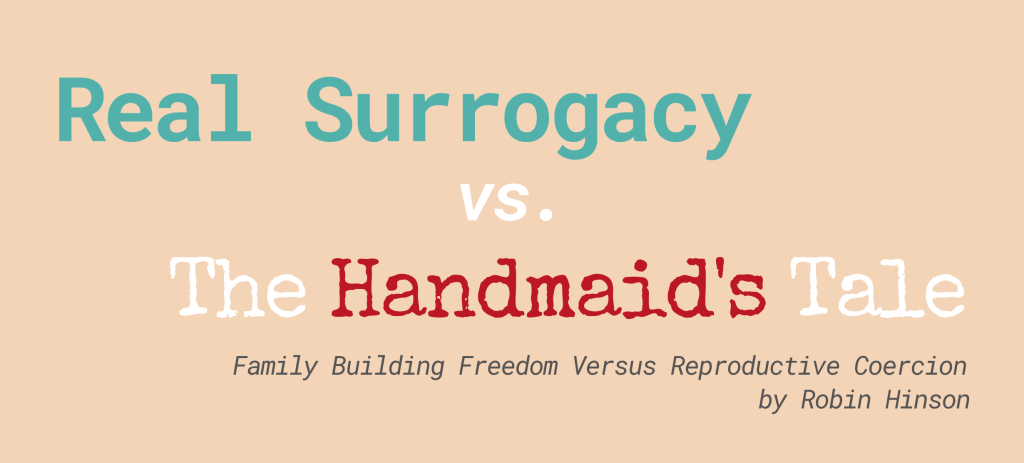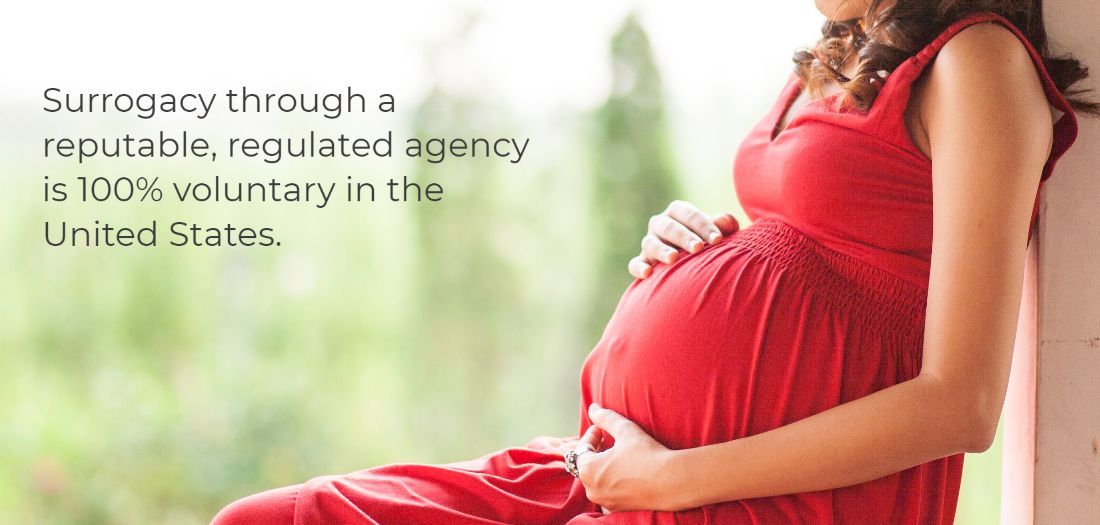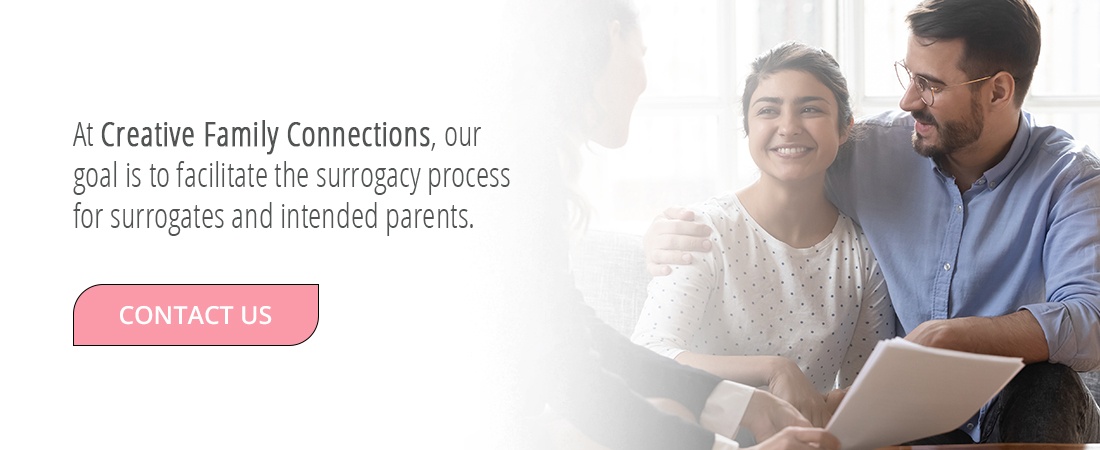
Season 4 of The Handmaid’s Tale on Hulu is premiering Wednesday, April 28, 2021 – We don’t know about you, but we are chomping. at. the. bit. for the return of this mind-altering dystopian drama based on the novel by Canadian author Margaret Atwood. Haven’t seen the new trailer? Watch it here. Content warning: Scenes in The Handmaid’s Tale could be extremely sensitive for anyone at any age because of the important social issues being explored (graphically) on the show.
This series — which began its first successful run on Hulu in 2017 — has sparked conversation about gender roles and reproductive freedom. We love the show for Elisabeth Moss’s jaw-dropping two-Emmy-Award-winning actress performance and producer roles. But let’s be real: A future world where infertility is ubiquitous and sexual assault replaces regulated surrogacy is, frankly, so terrifying. Real-world, regulated gestational surrogacy in the United States is one of the most worthwhile endeavors a surrogate or intended parent can embark on. But, of course, a few naysayers had to crash the party and care to disagree.
With the increasing clamor of vocal “feminist” celebrities, such as Gloria Steinem, who adamantly oppose commercialized surrogacy, surrogacy is getting a bad rap. In reference to the new surrogacy statute in New York, she is quoted as having said, “Under this bill, women in economic need become commercialized vessels for rent, and the fetuses they carry become the property of others.” Toss in several authors of newer novels supposedly about surrogacy (fictitious at best, harmful and disorienting at worst) and dramatized shows like Little Fires Everywhere (also on Hulu, which depicts traditional surrogacy), and the surrogacy world is being warped into a nightmare that it (almost always) is decidedly not.
Remember the important distinction: The society in The Handmaid’s Tale is an extremist theocracy led by misguided and often violent men that not only oppresses everyone, but also coerces the “Handmaids” into sexual slavery because of their predicted ability or past history of having a healthy pregnancy and delivery. In the show, a handmaid’s existence serves the sole purpose of bearing children for high status officials (“Commanders”) and their (also oppressed) wives, who have experienced multiple miscarriages and other infertility heartbreaks. All this to say, gestational surrogacy as it exists in today’s world, is not even depicted in The Handmaid’s Tale – What is depicted is an alternate reality where reproductive freedoms no longer exist legally or ethically, and anything outside the scope of heteronormativity is brutally rejected.
In the real world, the empowered choice to pursue surrogacy to help a couple or individual as a surrogate, or to grow your family as an intended parent, has thankfully become more mainstream. Surrogacy references in pop culture are drawing attention to this method of family building. For that, I am grateful. To this day, when I tell people that I work for a surrogacy agency, the spectrum of responses I see on peoples’ faces ranges from completely confused (“So you carry babies for other people?”) to beyond elated. And while dramatized shows and books about surrogacy might be deliciously entertaining, real-world knowledge is power, which is why we’re here to break down some of the myths depicted on The Handmaid’s Tale versus what a real-life surrogacy journey looks like.
Myth #1: Surrogates Always Have a Biological Connection to the Baby or Babies They Conceive
In traditional surrogacy, a surrogate — commonly called a “surrogate mother” — is artificially inseminated with the sperm of the intended father or another sperm donor to fertilize her own eggs. A traditional surrogate agrees to end her parental rights, and the infant legally becomes the child of the intended parents. This kind of surrogacy isn’t common practice these days because of the potential emotional and legal complications that can arise (as depicted in episode 2 of the show where this emotional attachment devastates Handmaid Janine). Seems obvious, right? Today, most surrogacy professionals advocate for gestational surrogacy. In gestational surrogacy, a surrogate, or “gestational carrier,” agrees to undergo in vitro fertilization for doctors to implant one (or sometimes two) embryos into her uterus. IVF physicians create these embryos using healthy egg and sperm, which may or may not be genetically connected to the intended parents, depending on their reproductive characteristics, fertility, or even personal preferences. #transrightsarehumanrights
Myth #2: Surrogates Have to Leave Their Home to Live with Intended Parents or Give Birth Where the Intended Parents Decide
In The Handmaid’s Tale, handmaids are forced to live with their oppressors or face physical punishments, torture, or even death if they don’t comply. Presumably from the show, handmaids are forced to do home births, without medical help, in the room over from their Commander’s wife, as is shown in episode 2, season 1.
Surrogates in the U.S. are not displaced from their own families and children for a surrogacy journey. Because the best predictor of a successful pregnancy is a prior pregnancy, a surrogate must have already had at least one child, so she knows she can healthily deliver a child for a prospective parent who needs her help. Surrogates should be supported and surrounded by their closest friends and family during such an amazing process. Surrogates, alongside their intended parents, choose their own preferred hospital nearby (typically with a Level II or Level III NICU just in case it’s needed) to give birth. They might have even delivered there previously with their own kids. If a surrogate is carrying twins, they also might see a maternal fetal medicine specialist for several appointments for extra, extra care. So long as a surrogate’s OBGYN is welcoming and supportive towards the biological parents – no matter their age, gender identity, race, and sexual orientation – OBGYN appointments for the parent(s) and surrogate can be an incredible way to bond during the journey! Intended parents do have some decision-making power when it comes to medical decisions about their baby during the birth, but all of these arrangements are carefully discussed beforehand.
Myth #3: Surrogates Don’t Have a Choice
The Handmaid’s Tale has raised intense conversations around reproductive ethics. The rising extremist leaders force fertile women into the role of “handmaids” for the purpose of bearing children for male “commanders” and their wives. (Content warning #2: Any dissenters and members of the LGBTQIA+ community are publicly murdered in the show.) Once handmaids give birth to their biological child, they have to hand the baby over to their “owners” with no parental rights, and are required to breastfeed and care for the baby in the same home as their oppressors. Handmaids are then shipped off as if they were cattle to another home to repeat the entire abuse all over again. (In real life, surrogates don’t typically breastfeed the baby. In fact, an intended parent can sometimes successfully induce lactation themselves so they can experience an amazing bonding moment. If only the show writers had depicted the Commanders’ wives inducing lactation, but then again, this future society doesn’t really believe in medicine, let alone reproductive science!)
We have said this before, and we’ll say it again: Surrogacy through a reputable, regulated agency is 100% voluntary in the United States. Uninformed celebrities (like Gloria Steinem) lack the requisite knowledge to claim, baselessly, otherwise. As a society, we need to learn to trust women and those with the ability to carry a child to make their own empowered, informed decisions in life. That trust includes whether someone agrees to help someone else build their family or not. Women who do opt to carry a child that is not their own are some of the most intelligent, passionate, and selfless women to ever walk this planet. I’ve personally met at least several hundred potential surrogates through Creative Family Connections’ in-home interview process. These visits, which were in-person prior to COVID and by Zoom during COVID, opened a window into the home life and world of these women, and were some of the most inspiring moments I’ll always remember. There’s no need to shy away from the fact that the financial benefits do help surrogates and their child(ren) by eliminating debt, or starting a college fund, or putting a down payment on a new house. These benefits are well-deserved, but never desperately needed – In fact, women who receive government assistance (food stamps and Medicaid insurance, for example) cannot become surrogates under our surrogate qualifications and that of many other top surrogacy agencies. The American Society of Reproductive Medicine (ASRM) guidelines do touch on the fact that a candidate should be rejected if there is “evidence of financial or emotional coercion” involved. Women who become surrogates have decided to become pregnant again because they want others to experience the same indescribable joy they’ve experienced with their own children. If someone is willing and able to make the decision to become a surrogate, then all the more power to them for wanting to make the world a better place.
Comment or question for the writer?
Robin Hinson can be reached at robin@creativefamilyconnections.com.
Die-hard fan of the show? Here’s the nitty-gritty
Real Gestational Surrogacy |
VS. |
The Handmaid’s Tale |
|
The IVF Center in a surrogacy journey is away from a surrogate’s home and is decided by the intended parents. The medical screening is a one-night trip and the transfer(s) is usually a two-night trip. Lost wages and stipends are given to surrogates for their time and dedication to this part of the process. |
IVF Center versus The Red Center |
The “Red Center,” as introduced in episode 1, is where the handmaids are forced to live temporarily to be indoctrinated (and possibly tortured) to learn the new rules of the Handmaid world. Multiple weeks and months of coercion and abuse. |
|
Surrogates and intended parents have various religious or spiritual beliefs. Everyone should be made aware of the others’ belief systems, but they don’t always play a big role in a surrogacy journey. A surrogate or intended parent might want to be matched with someone who shares similar religious beliefs. A surrogate’s faith might be one motivating factor to become a surrogate in the first place. It’s all about choice and being on the same page. |
Religion |
Handmaids are forced to believe “May God make me worthy” of being pregnant for the high-status officials. They must reference the theocracy’s religious scripture regularly aloud in public. There is no religious freedom or diversity whatsoever. |
|
Intended parents sometimes have a huge range of emotions in needing to seek a surrogate to have their baby. After all, an intended parent may have wanted to bring their child into the world themselves. Every intended parent has a story to tell about how they came to surrogacy and there might be heartaches in their history. But the relationship between a surrogate and intended parent can be absolutely beautiful and can even turn into life-long friendship. |
Relationship With The Parents |
The relationship between a Handmaid and the Commander’s wife is usually very strained in the show. After all, the commander’s wife has to sit behind her handmaid during ‘The Ceremony’ (sexual assault) with her husband. Of course that relationship would be awful and incredibly complex. |
|
Miscarriages can absolutely happen in surrogacy journeys, and they can be heartbreaking. There’s no place for blame. Surrogates sometimes take on the emotional blame themselves. After all, they want nothing more than to help another family. Sometimes miscarriages just happen. Sometimes journeys end after a miscarriage. Sometimes everyone will move forward together to a next transfer. |
Miscarriages |
In the show, Handmaids are explicitly blamed if they experience a miscarriage (in a future world where miscarriages are even more common than they are today). Handmaids are typically banished to a toxic wasteland if they have a miscarriage. |
|
Some intended parents want to conduct genetic testing during the journey, to include diagnostic information about Down Syndrome or similar conditions. Some intended parents may want the option to terminate a pregnancy in the rare event of a genetic difference where there is no or unknown quality of life. Viewpoints about these important topics need to be in alignment for a surrogate match. There is no right or wrong perspective, there is only a right or wrong match. |
Termination & Abortion |
In line with the extremist religious beliefs of the characters, abortion is sinful and prohibited on the show. |
|
Surrogacy contracts should always address potential mental health needs of a surrogate. If a surrogate wants to talk to someone during or after the journey, she absolutely should be able to. Intended parents see a counselor as well to prepare for a journey emotionally and mentally, and should see someone throughout the journey if needed. #endthestigma #mentalhealthmatters |
Mental Health |
There is little to no regard to a Handmaid’s mental health. The Commanders’ wives make derogatory comments. The Commanders are physically abusive. The list goes on and on for how mental health is ignored and stigmatized in the show. |
| A surrogate will usually travel alone for the medical screening trip, but can bring a support person for the transfer trip(s).
If a surrogate is with an agency, she has a dedicated journey coordinator to help with all kinds of details throughout the journey. For the hospital delivery, a surrogate might request the services of a doula during her delivery, usually at no cost to her. Her support at the hospital is also planned out well in advance of the delivery through a birth plan. And a surrogate can absolutely be single during a journey if she chooses to be. Support networks come in all shapes and sizes. |
Pregnancy & Delivery Support |
Handmaids must travel in duos always. During a delivery, a group of handmaids are present for the birth with the intention of helping support the handmaid who is in labor. There are only homebirths depicted with little to no medical assistance involved. |
Surrogacy with Creative Family Connections
At Creative Family Connections, our goal is to facilitate the surrogacy process for surrogates and intended parents. We are a full-service surrogacy agency founded and run by an attorney who is well-versed in the legal complexities of surrogacy. But there’s more to surrogacy than following the letter of whatever state law applies. We’ve seen firsthand the joy on a new parent’s face when they meet the child they never thought they’d have. We’ve seen the courage and commitment shine through the eyes of a surrogate who gives the gift of family to parents who have yearned to build or expand their family.
Those profoundly personal and emotional experiences drive us to provide high-touch support to surrogates and intended parents every step of the way. No two journeys are the same, and we promise to walk alongside and support our clients throughout the process. Whether you’re looking to complete your family through surrogacy or you want to give the gift of a child to someone else as a gestational surrogate, we are ready to help.


